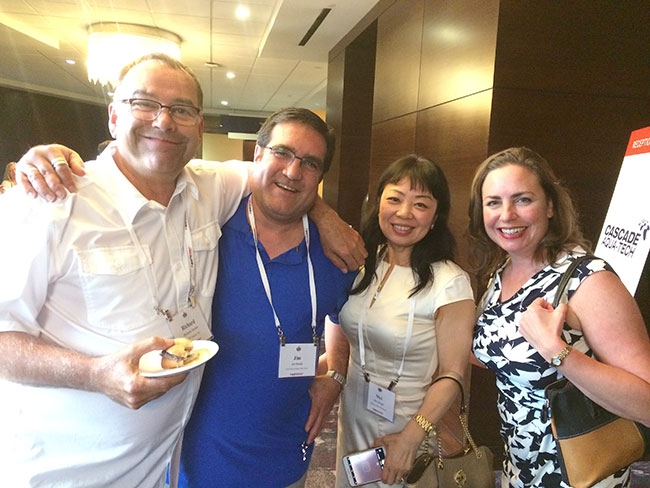
Features
Community
Event reports
Canadian Glass Association’s Glass Connections hits a home run in B.C.
Glass Connections B.C. hits all the right notes.
August 2, 2017 By Rich Porayko
 By travelling around the country, Glass Connections gives architectural glaziers a rare opportunity to mingle. Richard Verdon, Jim Brady, Wei Chen and Christine Jaynes appreciate the chance. credit: Rich Porayko
By travelling around the country, Glass Connections gives architectural glaziers a rare opportunity to mingle. Richard Verdon, Jim Brady, Wei Chen and Christine Jaynes appreciate the chance. credit: Rich PoraykoThe Canadian Glass Association’s Glass Connections conference hit a home run when it returned to Burnaby, B.C., in June, offering high caliber educational and networking opportunities with local, national and U.S. glazing leaders. The welcome reception on June 7 was a success with many sticking around until late singing everything from “Sweet Caroline” to “Sweet Child o’ Mine” at the casino’s dueling piano bar.
Glazing restoration was a major theme of the conference with Tremco’s senior building envelope specialist, Bill Cardott, kicking off the full-day program. “Upgrading glazing systems for energy performance is probably one of the first things people are looking for nowadays in a glazing restoration,” said Cardott. “Just upgrading to wet seals to reduce air leakage improves energy performance. But there are all of the other typical reasons for a restoration: fixing something that was done wrong in the first place, solving leaks, improving the esthetic or changing a system that has simply worn out.”
There are a lot of potential causes of glazing failures. Some of them are readily recognizable while others are not as obvious. “When someone says ‘my windows are leaking,’ it’s very important to look at the interconnections,” said Cardott. “When you look at the interconnections, a lot of times it’s not related to the window. It’s the connections.
“With all the differences in glazing and potential remedies, it’s really important that every single glazing restoration project begin with a licensed professional who’s properly equipped and trained to survey the conditions and find out what’s really wrong and find out what can be achieved with the window system in terms of performance,” he went on.
With the advent of fire-resistive products, there are many more options at your disposal from a design standpoint compared to just a few years ago. Tim Nass of Safti First emphasized that natural daylight is an important consideration. “The system looks like a standard interior storefront, but in fact is a two-hour fire barrier. Glass and frame work in concert together to control the visual elements as well as the energy generated. You see the flexibility in design.”
Nass told attendees that codes are evolving to where he sees demand for these products on the exterior of the building. “When you incorporate a soft coat low-E, you can be assured you are going to be getting impressive solar heat coefficients, U-values and condensation-resistance factors,” said Nass. “There is no degradation in performance when these products are incorporated into the building envelope. They have been tested statically as well as dynamically. These products enhance from a code perspective as well as from an overall performance and esthetic perspective.”
Canada is going through a big code transition. Wired glass has lost its safety designation in the National Building Code. “Does fire-rated mean that it’s safety rated? The answer is ‘No.’,” said Nass. “They are mutually exclusive. Just because a product is fire-rated, doesn’t mean that it is safety rated. However, products in the market today are tested for both. Wired glass has been used across Canada. It was given an exemption for a safety rating because it was the only rated product on the market.”
Wired mesh products give the illusion of security, durability and strength. According to Nass, it actually weakens the glass by half. “The issue is that not only does the glass break, it remains in the opening,” says Nass. “An individual who penetrates that opening can cause serious damage to themselves because of the wire mesh. It’s very gruesome. I read that the Ontario School Board insurance exchange incurred $6 million from 2001 to 2015. It’s one of the most heavily litigated aspects of fenestration. They go after the glazier. You’re the glazing professional. You’re the expert in their eyes.”
Nass said wired glass that does not comply with safety standards is illegal. “They are coming to look for you if you put that piece of glass in and something happens. Be aware of that. There are better options than the wired product.”
“When someone calls me and says ‘I have a problem with my glazing,’ it usually breaks down into a couple of issues,” said Brian Hubbs of RDH Building Science. “Condensation on the interior when it gets cold out. That’s a very common one. Sliding patio doors tend to go pretty quickly. That’s very indicative of the IGU losing its edge seal. Condensation on the exterior is common but it’s not an actual defect. I get calls on it all the time. That’s just high-performance glass.”
Hubbs believes that the durability of the glazing units is the single biggest aspect of an IGU. “It has to be airtight. It has to be moisture-resistant. It has to have a good vapour barrier.”
“Corrosion of low-E coatings often correlates well with high dew points,” Hubbs went on. “If there is a low-E coating on it and you look carefully and see fingerprint marks and roller marks, you can often tell that it has condensed. It has corroded that low-E coating and it just isn’t full of water right now.”
Hubbs feels that in-situ repairs of IGUs are rarely practical. “I have never found one that is really good unless someone forgot to seal a capillary tube, it is really early on and hasn’t failed the unit yet.”
With Canada moving towards the Passive House standard, Hubbs told the audience that the industry is going to be throwing everything we can at our glazing systems to be as energy efficient as possible. “Argon will be a critical part of this process to get to the levels that we need to get for Passive House. So you’re really going to want to make sure that argon is actually in your units. I provide a quality assurance role that things are as specified. When it comes to air, water and thermal, I can sign a letter of assurance that this building meets the requirements that we set. So I want to make sure that there’s argon there.”
Being a clear, colourless and odorless gas, the presence of argon is pretty difficult to confirm. “A nice way to make sure is to go to the plant and check that they are doing it properly,” said Hubbs. “There are some plants where the IGU assembly is an argon-filled room where it is very hard to make a mistake. Other plants drill two holes and fill the gas until a buzzer goes off. There are a lot of ways to do it. Unlike past years, it didn’t really matter because no one would ever know if the argon was there. In the future years, two or three years from now, it will matter and people will know if it’s not there.”
RDH tested 100 random units in the field for argon. Hubbs told attendees all IGUs were manufactured within one to four months previously so there was no argument that the argon diffused through the spacer. “If the argon wasn’t there, it wasn’t put in or it escaped before it was sealed. Three percent had concentrations above 90 per cent argon fill. Twenty-five per cent had concentrations between 75 and 90 per cent, and 11 per cent had concentrations between 50 and 75 per cent. Sixty-one percent had no measurable argon. Some of the initial studies out of IGMA say you can easily expect argon to last the life of the unit if it is built properly.”
So what is Passive House and why is making sure argon is actually inside your IGUs so important? According to Monte Paulsen, also of RDH Building Science, a simple way of thinking about Passive House is that it is a building with a sweater around it that is so thick that you wouldn’t need and could not install a furnace.
“We super-insulate the building with very thick walls, ceilings and floors,” said Paulsen. “In the residential scale, we are typically talking walls in the R50 to R60 range. If we move to an apartment building where we have better form backer, the walls are in the R30 to R40 range. They have much more stringent air tightness in the range of 0.6 air changes per hour.”
Thermal bridges are being eliminated. “We’re designing out those places where concrete and metal window frames transmit energy through the building enclosure,” said Paulsen. “Triple-pane glazing in every instance until we start talking about northern Canada, where we are looking at quadruple-pane glazing. Mechanical ventilation with a minimum of 75 per cent heat recovery, although we are always looking for heat recovery in the 90 to 95 per cent range.”
And finally, just a little bit of heat. Paulsen said a typical passive house will only need a few BTUs of heat in December and in January and you won’t even see the meter run the rest of the year. In a recent Passive House project in Langley, B.C., a family of five went through the winter and didn’t notice that the heating system wasn’t connected. You could literally heat it with a hair dryer, if you needed to.
“The ticket item that is the sticker shock for every developer is windows because they are automatically tossing out the double pane window option and looking at high-performance triple-pane windows,” said Paulsen. “If there is a sector in the industry poised to do very well on the move to Passive House, its glazing.”
Rounding out the event was Mikhala Way of Vitrum Industries on designing with bird-friendly glass. According to Way, up to 600 million birds are killed every year in Canada and the United States from collisions with glass, more than pesticides and oil spills combined. Way told attendees that buildings need to meet a number of different criteria to be considered bird-friendly. “From grade to 40 feet high is the main collision area for bird strikes,” said Way. “Ninety per cent of this glazing area needs to include a bird-friendly substance with a minimum of 70 per cent avoidance. Above the 40-foot mark, the building needs at least 60 per cent bird-friendly glazing to meet the requirements. A bird-friendly building can’t have any transparent passage ways that can trap birds in a courtyard or atrium.”
Lighting at night needs to be limited and strategically located, never pointing to the sky where birds can get trapped in the beam.
“Depending on the time of day and the angle in which you are looking, most glass can give you a very high reflectivity rate which reflects the surrounding vegetation,” said Way. The birds don’t see the glass rather than what is being reflected off of it. “Bird-safe glass is specially designed to make glass a visible obstacle to birds. There are a variety of approaches including using glass with a ceramic frit, etched, or UV pattern to help break up reflectivity to alert birds to its presence.”
“As long as there is some kind of visual noise, the birds should see it,” explained Way. “For silkscreen and etched glass, you want to follow a two-by-four-inch rule on the exterior surface with at least five per cent coverage. You can place it on surface #2 however where the reflectivity of the first surface is more effective. Ceramic frit gives you a lot of options with branding, design and colours. Screens, shutters and external shades all help to break up an expanse of exposed façade to make it visible to birds.”
Glass Connections attendees also heard about the all-important standards for glass balcony guards. The important thing for people to realize is that while the Canadian General Standards Board withdrew seven glass codes including the code for strength and design, it can still be referenced. Glaziers can also look at the CSA A500-16 for guardrail glass. It’s a new standard and an excellent resource that will be implemented in the National Building Code as well as the provincial building codes.
Closing off the final Glass Connections of Jim Brady’s multi-year tenure, Brady took time and thanked Richard Verdon of RSVP Agency for his many years of service to the Canadian glass industry and provided personal insight on what it means to be a leader. “I’ve always lived by the mantra that we have to give back to the associations and the industry that provides for us. You have to feed it so it can feed you. I’ve been doing some type of volunteering since 1999. I’m going to stay on for one more year as past president and then I’m going to let the next generation come forward.
Rich Porayko is a professional writer and founding partner of Construction Creative.
Print this page



Leave a Reply